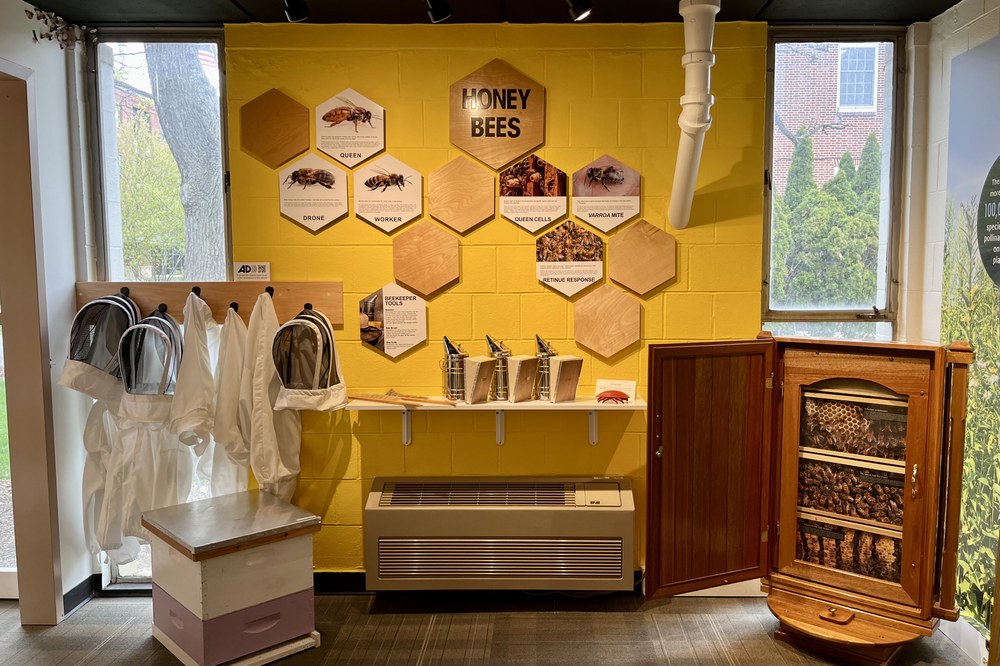Explore aspects of honey bee biology and behavior, plus showcased tools used in beekeeping, such as a Langstroth hive, smokers, and brushes. Try on a bee suit!

Honey bee exhibit at the Frost Entomological Museum
Some topics covered in our honey bee exhibit:
Castes
Worker bees are responsible for many roles in the colony. As young adults they tend to developing larvae. In middle age they take on diverse duties, like guarding the hive, housekeeping, and building comb with wax. Some individuals even serve as undertakers, removing dead bees from the hive. The oldest worker bees are the foragers, who leave the colony to collect pollen and nectar. All workers are daughters of the queen. They spend their lives working with their sisters and will never reproduce. Workers are the most commonly encountered honey bees.
Male honey bees are called "drones" and they do no work for the colony. Their primary function is to mate with queens. During the spring, they will fly to a “congregation site” where they encounter other drones and unmated queens from other colonies. After mating, the drones die. Drones are recognizable by their large eyes and low activity in the colony.
There is only one queen in a honey bee colony. She is the mother of all the bees, and her role in the colony is to lay eggs. Healthy queens can lay over a thousand eggs per day and are recognizable by having a much longer abdomen than workers. A queen will mate with multiple males and will store the sperm for the rest of her life. She can then determine the sex of her offspring by choosing to fertilize the egg (female) or not (male). Beekeepers often apply a drop of paint to the queen’s thorax, to make her more visible within the group.
Retinue response
Healthy queens release an odor, called queen mandibular pheromone, that induces certain behaviors in the workers. Workers are attracted to the queen and will surround her and feel her with their antennae. The workers groom the queen and collect the pheromone to share with the rest of the colony. Queen mandibular pheromone also prevents workers from rearing new queens, and it attracts drones during mating.
Queen cells
Queen cells are built in the honeycomb alongside regular cells and are shaped like peanuts. They are larger than regular cells because queens are larger than worker bees and they need more space to develop. If queen cells are seen when the colony is healthy, then the colony plans to swarm. This means approximately half the colony will leave to establish in a new location. If queen cells can be seen when the colony is weak, then it means workers are planning to replace their current queen.
Bee Keeper Tools
- Smoker - Beekeepers calm bees when interacting with the hive by blowing smoke at them. Although this trick has been used for hundreds of thousands of years, it was only recently discovered that smoke temporarily decreases the bee’s ability to sense alarm pheromones. Can you figure out how the smoker works?
- Bee Brush - Beekeepers can gently remove bees from the frames of a honey bee hive by brushing the surface with this soft bristled brush. Can you brush the bees off the frames in our hive?
- Bee Suits - Beekeepers often wear suits that protect against stings from defensive bees.
Varroa Mite
This mite is an invasive parasite that feeds on a tissue in the bee called a “fat body”. Fat bodies serve as nutrient storage for the bee, so depletion of this tissue leaves the bee in a weakened state. Varroa mites also vector several viruses and, depending on the infestation levels in the hive, can destroy entire colonies. Appropriately, the scientific name for this mite is Varroa destructor.
The Frost Entomological Museum
Hours: Monday-Friday 10am-4pm
The Frost Entomological Museum
Hours: Monday-Friday 10am-4pm

